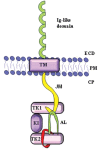An overview on the role of FLT3-tyrosine kinase receptor in acute myeloid leukemia: biology and treatment
- PMID: 25992210
- PMCID: PMC4419636
- DOI: 10.4081/oncol.2012.e8
An overview on the role of FLT3-tyrosine kinase receptor in acute myeloid leukemia: biology and treatment
Abstract
Hematopoiesis, the process by which the hematopoietic stem cells and progenitors differentiate into blood cells of various lineages, involves complex interactions of transcription factors that modulate the expression of downstream genes and mediate proliferation and differentiation signals. Despite the many controls that regulate hematopoiesis, mutations in the regulatory genes capable of promoting leukemogenesis may occur. The FLT3 gene encodes a tyrosine kinase receptor that plays a key role in controlling survival, proliferation and differentiation of hematopoietic cells. Mutations in this gene are critical in causing a deregulation of the delicate balance between cell proliferation and differentiation. In this review, we provide an update on the structure, synthesis and activation of the FLT3 receptor and the subsequent activation of multiple downstream signaling pathways. We also review activating FLT3 mutations that are frequently identified in acute myeloid leukemia, cause activation of more complex downstream signaling pathways and promote leukemogenesis. Finally, FLT3 has emerged as an important target for molecular therapy. We, therefore, report on some recent therapies directed against it.
Keywords: FLT3 receptor; acute myeloid leukemia; inhibitors.; internal tandem duplication; signal transduction networks.
Conflict of interest statement
Conflict of interests: the authors declare no potential conflict of interests.
Figures




References
-
- Gilliland GD. Molecular genetics of human leukemias: new insights into therapy. Semin Hematol. 2002;39:6–11. - PubMed
-
- Motyckova G, Stone RM. The role of molecular tests in acute myelogenous leukemia treatment decisions. Curr Hematol Malig Rep. 2010;5:109–117. - PubMed
-
- Gilliland DG, Jordan CT, Felix CA. The molecular basis of leukemia. Hematology Am Soc Hematol Educ Program. 2004:80–97. - PubMed
-
- Vardiman JW, Thiele J, Arber D, et al. The 2008 revision of the World Health Organization (WHO) classification of myeloid neoplasms and acute leukaemia: rationale and important changes. Blood. 2009;114:937–51. - PubMed
Publication types
LinkOut - more resources
Full Text Sources
Other Literature Sources
Miscellaneous

